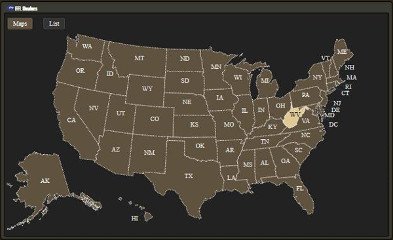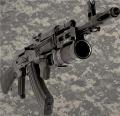The FN P90 is a selective fire personal defense weapon (PDW) designed and manufactured by FN Herstal in Belgium. The P90's name is taken from 1990, the year the weapon was introduced. The P90 was created in response to NATO requests for a replacement for 9x19mm Parabellum firearms. It was designed as a compact but powerful firearm for vehicle crews, operators of crew-served weapons, support personnel, special forces and counter-terrorist groups.
The P90 was designed in conjunction with the FN Five-seven pistol and 5.7x28mm ammunition. The P90 was developed from 1986 to 1990. It was introduced in 1990, and the Five-seven was introduced in 1998 as a companion pistol using the same 5.7x28mm ammunition. The P90 was originally intended for military and law enforcement customers, but since 2005, it has also been offered to civilian shooters as the PS90, a semi-automatic sporting model with a lengthened barrel.
The P90 is an unconventional weapon with a futuristic appearance. It features a compact bullpup design with fully ambidextrous controls and an integrated reflex sight, and it incorporates several innovations such as a unique top-mounted magazine and FN's small caliber, high velocity 5.7x28mm ammunition.
The P90 is currently in service with military and police forces in over 40 countries throughout the world. Further development of the P90 platform led to the creation of the P90 TR variant, which has a MIL-STD-1913 triple rail interface for mounting accessories. This variant was introduced in 1999 and continues to be offered alongside the standard P90. More recently, the P90 has been offered to civilian shooters, in various configurations, as the PS90. This is a semi-automatic sporting carbine with a lengthened 407 mm (16.0 in) barrel.
FN states that the P90 has an effective range of 200 m (655 ft) and a maximum range of 1,800 m (5,905 ft) and a rate of fire of 900 rounds per minute. In testing in 1999 by the Royal Canadian Mounted Police (RCMP), the SS190 fired from the P90 at a distance of 25 m (82 ft) exhibited an average penetration depth of 25 cm (9.85 in) in ballistic gelatin covered with a Level II vest. In testing done by Houston Police Department SWAT, the SS190 fired from the P90 typically exhibited 28 to 34 cm (11 to 13.5 in) penetration in bare ballistic gelatin. The SS190 and similar 5.7x28mm projectiles have been shown to turn base over point ("tumble") in testing in ballistic gelatin and other media, using the 21.6-mm (.85 in) projectile length to create a larger wound cavity. However, some are skeptical of the bullet's terminal performance, and it is a subject of debate among civilian shooters in the United States.
The 5.7x28mm projectiles are statistically safer than others, because the projectile designs limit overpenetration and the projectiles have a low risk of ricochet. Since the SS190 projectile does not rely on fragmentation or the expansion of a hollow point, the cartridge (and 5.7x28mm weapons) are considered suitable for military use under the Hague Conventions of 1899 and 1907, which prohibit use of expanding or fragmenting bullets in warfare.
The above was for the most part taken from Wikipedia, being an open wiki there's really no need to credit them but thought I would in any case. This gun first drew my attention as the primary weapon on the Stargate movie and television series and later in the Counter-Strike video game. I've been fascinated with it ever since

 GunNook strives to be more than just a distributor of high quality goods and wares. We want to connect with our members and clients. Whether it be an organization, distributer, or an individual person. We want to make sure you’re informed on not only products of interest, but also events, how-tos and others happenings of interest.
GunNook strives to be more than just a distributor of high quality goods and wares. We want to connect with our members and clients. Whether it be an organization, distributer, or an individual person. We want to make sure you’re informed on not only products of interest, but also events, how-tos and others happenings of interest.



 Get your next custom PVC morale patch made here! We guarantee the cheapest price because we cut out the middleman. If you can find a cheaper price, we'll match it GUARANTEED. Velcro hook backing is included on all patches, unless otherwise specified.
Get your next custom PVC morale patch made here! We guarantee the cheapest price because we cut out the middleman. If you can find a cheaper price, we'll match it GUARANTEED. Velcro hook backing is included on all patches, unless otherwise specified.











 There's no registration needed with Facebook login, sign-in with Facebook instantly by clicking on Connect With Facebook to the top right! Or register and login traditionally. By registering you'll be entered in prize drawings, exclusive deals, free stuff and more just for being active, read articles, and reviews; all for free.
There's no registration needed with Facebook login, sign-in with Facebook instantly by clicking on Connect With Facebook to the top right! Or register and login traditionally. By registering you'll be entered in prize drawings, exclusive deals, free stuff and more just for being active, read articles, and reviews; all for free. GunNook on Facebook
GunNook on Facebook Youtube Channel
Youtube Channel Twitter
Twitter Instagram
Instagram Tactical Warehouse
Tactical Warehouse




 Reply With Quote
Reply With Quote
